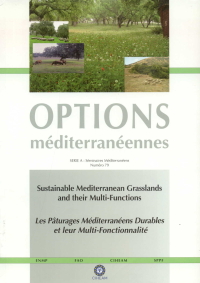| Article précédent | p. 423-426 | Article suivant |
Dry matter yield, earliness and plant regeneration of different subclover cultivars in southern Italy
Research was conducted over a 4-year period (1994-1997) on the Gaudiano di Lavello field (Basilicata region), 180 m a.s.l., 41° 3' N, 15° 48' E, on a sandy-loam soil. Twelve cultivars of Trifolium brachycalycinum (3), Trifolium subterraneum (7) and Trifolium yanninicum (2) were compared using a randomized block design with 3 reps and a plot area of 1 m2. The following parameters were analysed for the 4-year period: (i) dry matter yield (DMY); (ii) biomass distribution during the year (BD); (iii) plant height (PH); (iv) flowering earliness (FE); and (v) plant regeneration (PR). DMY as a mean of a 4-year period ranged from 6.8 (T. brachycalycinum cv. Nuba) to 4.1 t/ha (T. subterraneum cv. Junee). BD calculated in fall, winter and spring period reached the highest values in spring (56%) while it was lower in winter (28%) and fall (16%). pH shows a wide range of variability between cultivars. As to FE it ranged from April 3 (T. subterraneum cv. Woogenellup) to April 23 (T. yanninicum cv. Larisa). PR, expressed as number of seedlings/m2, varied from 2808 (T. subterraneum cv. Enfield) to 1555 (T. brachycalycinum cv. Nuba).
Des recherches ont été effectuées pendant 4 ans (1994-1997) dans un champ expérimental du territoire de Gaudiano di Lavello (région de la Basilicata), situé a 180 m d'altitude, 41° 3' N, 15° 48' E, sur un terrain sableux-limoneux. Douze cultivars appartenant à Trifolium brachycalycinum (3), Trifolium subterraneum (7) et Trifolium yanninicum (2) ont été comparés en utilisant un exemplaire répliqué 3 fois sur une parcelle d'un m2. Les paramètres suivants ont été analysés pendant 4 ans : (i) production de matière sèche (PMS); (ii) distribution de la biomasse au cours de l'année (DB); (iii) taille de la plante (TP); (iv) précocité de la floraison (PF); et (v) régénération de la plante (RP). La PMS, comme moyenne sur 4 ans, variait de 6,8 (T. brachycalycinum cv. Nuba) à 4,1 t ha-1 (Trifolium subterraneum cv. Junee). La DB calculée en automne, en hiver et au printemps, a atteint les valeurs les plus élevées au printemps (56%), par rapport à l'hiver (28%) et l'automne (16%). La TP montre une large gamme de variabilité pour les cultivars. Quant à la PF, elle oscillait entre le 3 avril (T. subterraneum cv. Woogenellup) et le 23 avril (T. yanninicum cv. Larisa). La RP, exprimée comme le nombre de plantules/m2, variait de 2808 (T. subterraneum cv. Enfield) à 1555 (T. brachycalycinum cv. Nuba).
- [ Afficher ]
- [ Télécharger ]
- [ Exporter la citation ]
Vous pouvez télécharger la citation au format :
- [ Imprimer ]
-
Mots-clés
AMELIORATION DES PATURAGES, BIOMASSE, CARACTERE AGRONOMIQUE, EXPERIMENTATION, ITALIE, LEGUMINEUSE FOURRAGERE, TREFLE, TRIFOLIUM, TRIFOLIUM SUBTERRANEUMCiter cet article
Corleto A., Cazzato E. Dry matter yield, earliness and plant regeneration of different subclover cultivars in southern Italy. In : Porqueddu C. (ed.), Tavares de Sousa M.M. (ed.). Sustainable Mediterranean grasslands and their multi-functions . Zaragoza : CIHEAM / FAO / ENMP / SPPF, 2008. p. 423-426. (Options Méditerranéennes : Série A. Séminaires Méditerranéens; n. 79). 12. Meeting of the Sub-Network on Mediterranean Forage Resources of the FAO-CIHEAM Inter-regional Cooperative Research and Development Network on Pastures and Fodder Crop, 2008/04/09-12, Elvas (Portugal). http://om.ciheam.org/om/pdf/a79/00800689.pdf



